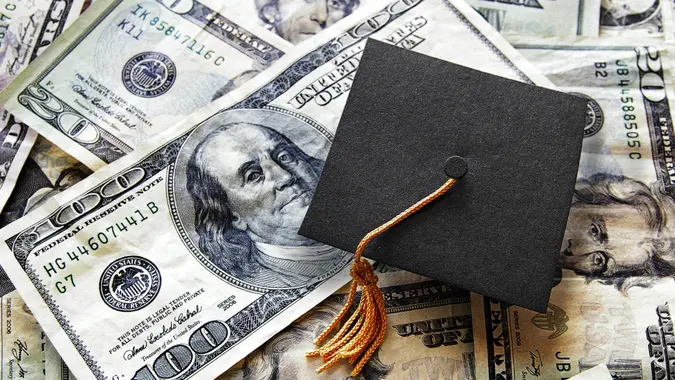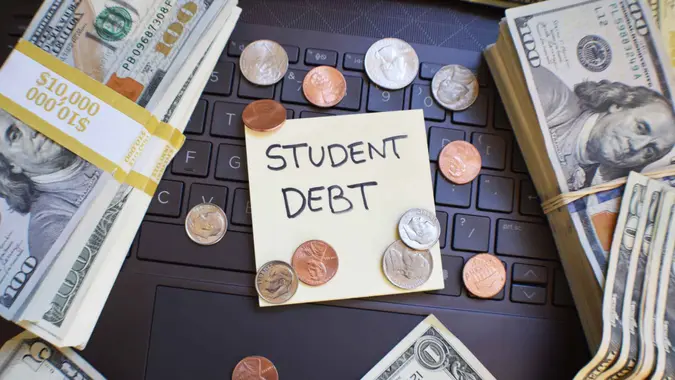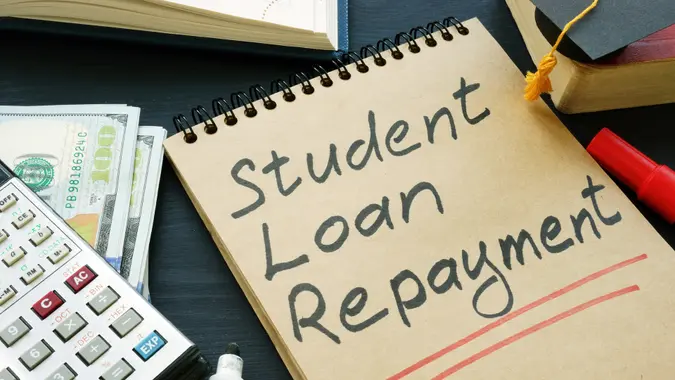6 Options You Still Have for Student Loan Forgiveness Under Trump

Commitment to Our Readers
GOBankingRates' editorial team is committed to bringing you unbiased reviews and information. We use data-driven methodologies to evaluate financial products and services - our reviews and ratings are not influenced by advertisers. You can read more about our editorial guidelines and our products and services review methodology.

20 Years
Helping You Live Richer

Reviewed
by Experts

Trusted by
Millions of Readers
Trump has shaken things up in the world of student loans. From blocking the SAVE plan, to firing workers at the Department of Education, to limiting the forgiveness reach of some student loan forgiveness programs — borrowers are worried and for good reason.
But student loan forgiveness is still available for borrowers on some plans. We’ll review how to qualify, how much may be forgiven, and how to apply for those plans going forward.
6 Options For Student Loan Forgiveness Under Trump
There are still some programs that allow you to (potentially) get some of your student loan balances forgiven.
Public Student Loan Forgiveness
While Trump recently signed an executive order that may limit the reach of the Public Student Loan Forgiveness (PSLF) Program for some employers. But PSLF is still in place — and if you work for a qualifying non-profit, you could get your loans forgiven after 10 years of qualifying payments are made (120 total payments).
PSLF is a program for people who work in public service in federal, state, tribal, or local government, or for a non-profit organization. This can include teachers, nurses, doctors, and other public service positions.
You can get on an income-driven repayment plan, make on-time payments, and once you have 120 qualifying payments, you can submit your application for forgiveness.
Income-Based Repayment (IBR) Plans
While many income-driven repayment (IDR) plans are on pause or may be going away, you may still be able to get forgiveness using an income-based repayment (IBR) plan. These plans are separate from IDR plans and offer loan forgiveness after 20 years of on-time payments.
The IBR plan bases your monthly payment on a percentage of your discretionary income. While the calculation is somewhat complicated, the current IBR plan (for loans first borrowed after July 1, 2014) limits monthly payments to 15% of your discretionary income.
If you still owe money after 20 years of making payments on your IBR plan, the remaining loan balance may be forgiven.
Teacher Loan Forgiveness
If you’re a teacher, you may qualify for a separate loan forgiveness plan called teacher loan forgiveness. If you’re a teacher who teaches full time for five complete and consecutive academic years in a low-income school or educational service agency (and meet other qualifications), you may be eligible to have up to $17,500 of your federal student loans forgiven.
To be eligible, you need to be employed by an elementary school, secondary school, or educational service agency that serves low-income students. And this plan cannot be combined with public student loan forgiveness (PSLF), so it’s important to run the numbers and choose the one that makes sense for you.
Borrow Defense (If Your School Closes or You Were Misled)
If you went to a school that ends up closing while you’re enrolled, or if you were misled to enroll in the school on false pretenses, you may be eligible for complete student loan discharge by applying for borrower defense through the StudentAid.gov website.
Borrow Defense is designed to protect borrowers who believe that their school misled them or lied to them about something central to their decision to enroll. This is known as “misrepresentation” and has affected borrowers in certain schools.
This includes schools that promise certain accreditation after graduation, guarantee jobs or starting salaries after getting a degree, or promise that credits will transfer to other schools. You’ll need to submit an application for your borrower defense case to be reviewed.
Total and Permanent Disability
If you become totally and permanently disabled, you may be eligible for loan forgiveness using total and permanent disability (TPD) discharge. To qualify, you’ll need to submit a TPD discharge application and provide documentation from one of three sources:
- The U.S. Department of Veterans Affairs (VA)
- The Social Security Administration (SSA)
- A physician
If accepted, your loans will be forgiven in full, and the forgiven amount won’t be counted as taxable income for TPD discharges after Jan. 1, 2018.
State Student Loan Forgiveness Programs
Outside of federal student loan forgiveness programs, some states offer student loan forgiveness as well. Many of these programs are designed to help pay off student loans for state employees and other workers.
The Institute of Student Loan Advisors tracks the current student loan forgiveness programs by state.
More From GOBankingRates
Sources:
- The White House, Restoring Public Service Loan Forgiveness
- Federal Student Aid, Income-Driven Repayment Plans
- Federal Student Aid, Teacher Loan Forgiveness
- Federal Student Aid, Borrower Defense Loan Discharge
- The Institute of Student Loan Advisors
 Written by
Written by  Edited by
Edited by 























